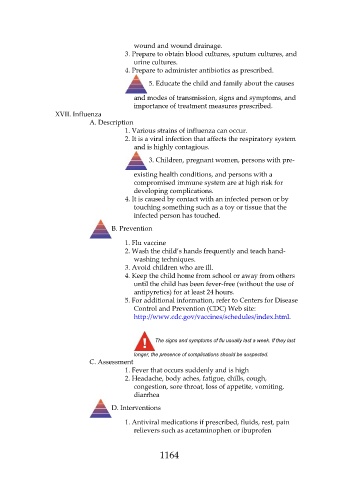Page 1164 - Saunders Comprehensive Review For NCLEX-RN
P. 1164
wound and wound drainage.
3. Prepare to obtain blood cultures, sputum cultures, and
urine cultures.
4. Prepare to administer antibiotics as prescribed.
5. Educate the child and family about the causes
and modes of transmission, signs and symptoms, and
importance of treatment measures prescribed.
XVII. Influenza
A. Description
1. Various strains of influenza can occur.
2. It is a viral infection that affects the respiratory system
and is highly contagious.
3. Children, pregnant women, persons with pre-
existing health conditions, and persons with a
compromised immune system are at high risk for
developing complications.
4. It is caused by contact with an infected person or by
touching something such as a toy or tissue that the
infected person has touched.
B. Prevention
1. Flu vaccine
2. Wash the child’s hands frequently and teach hand-
washing techniques.
3. Avoid children who are ill.
4. Keep the child home from school or away from others
until the child has been fever-free (without the use of
antipyretics) for at least 24 hours.
5. For additional information, refer to Centers for Disease
Control and Prevention (CDC) Web site:
http://www.cdc.gov/vaccines/schedules/index.html.
The signs and symptoms of flu usually last a week. If they last
longer, the presence of complications should be suspected.
C. Assessment
1. Fever that occurs suddenly and is high
2. Headache, body aches, fatigue, chills, cough,
congestion, sore throat, loss of appetite, vomiting,
diarrhea
D. Interventions
1. Antiviral medications if prescribed, fluids, rest, pain
relievers such as acetaminophen or ibuprofen
1164

